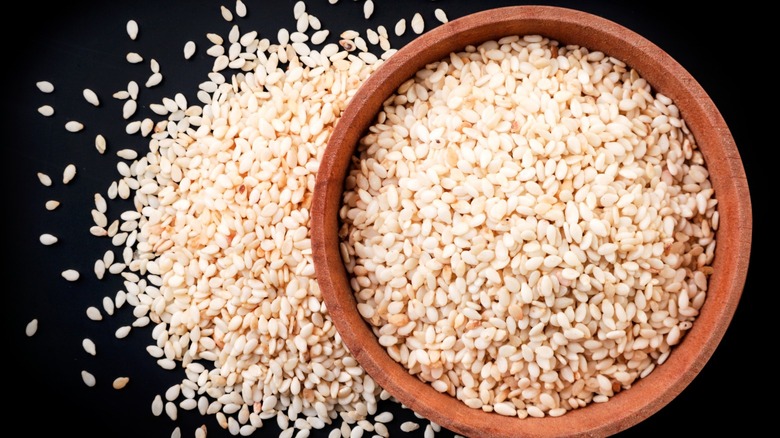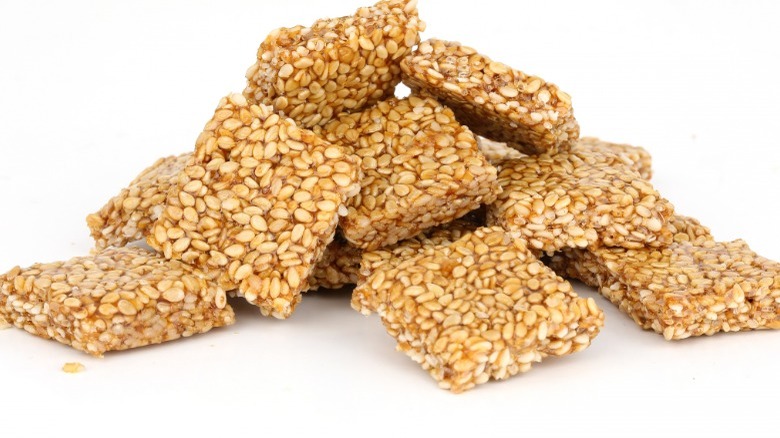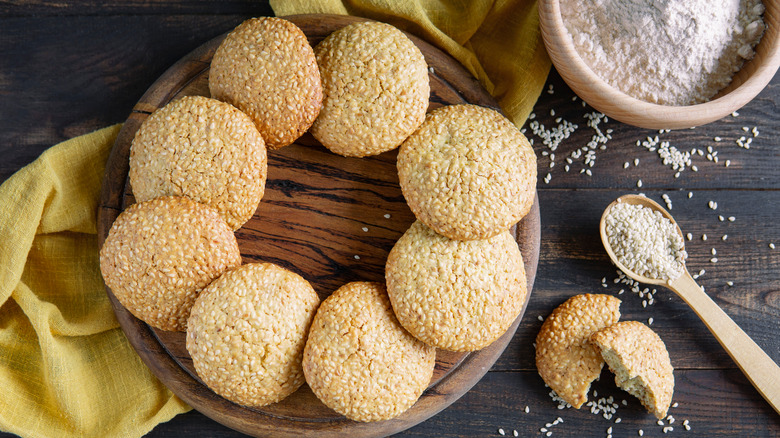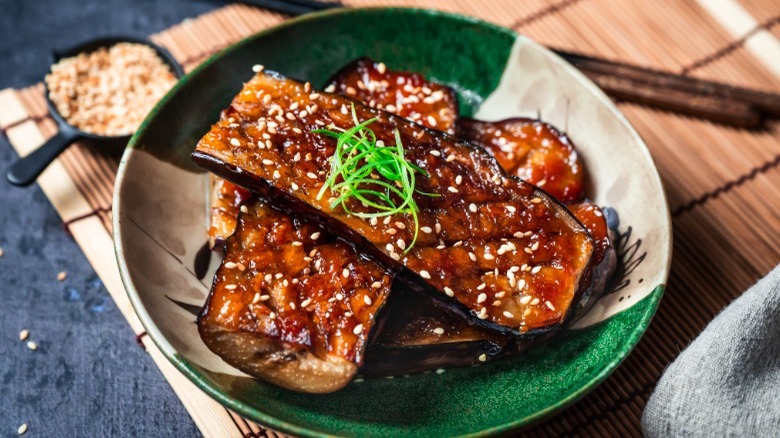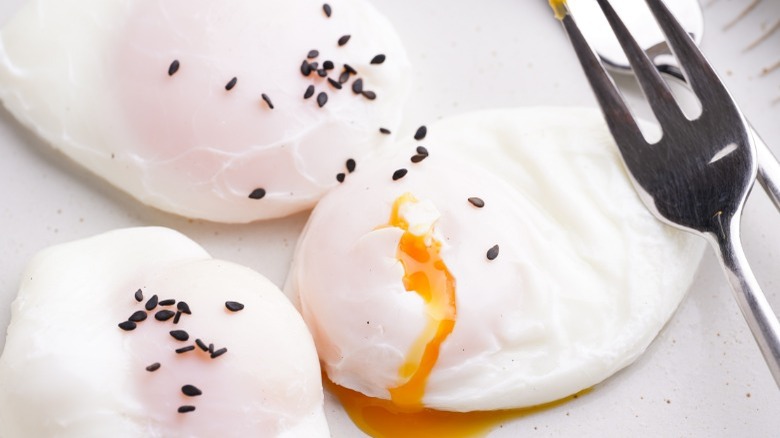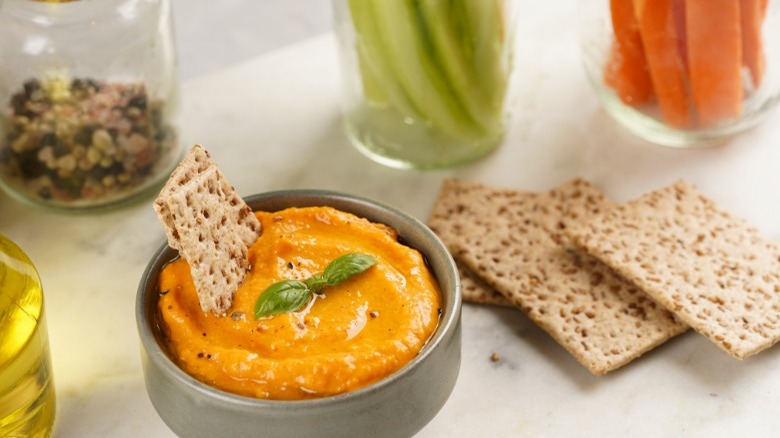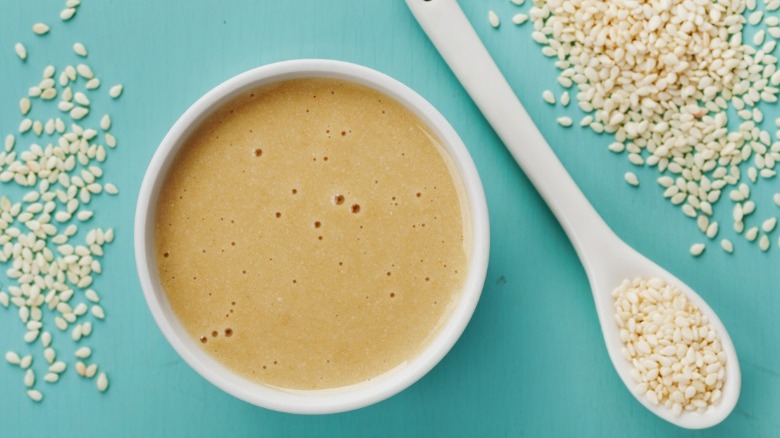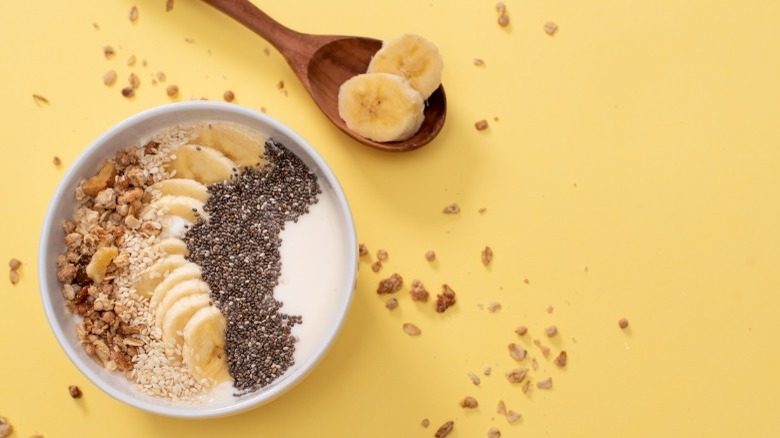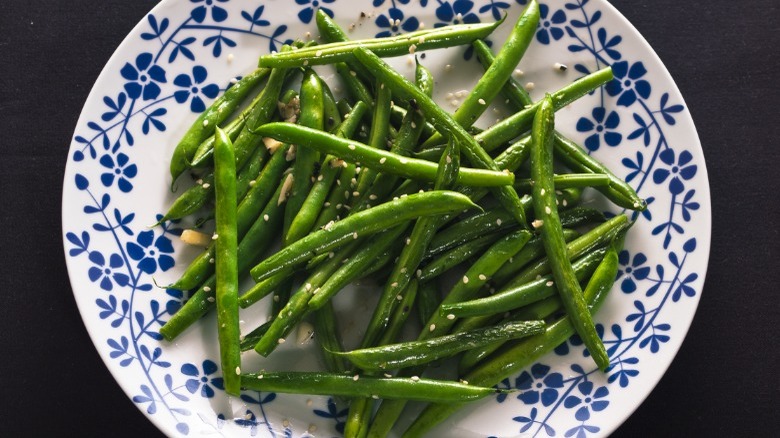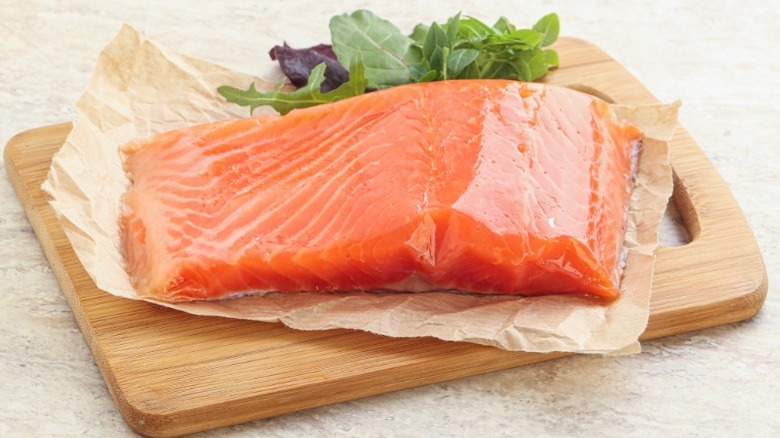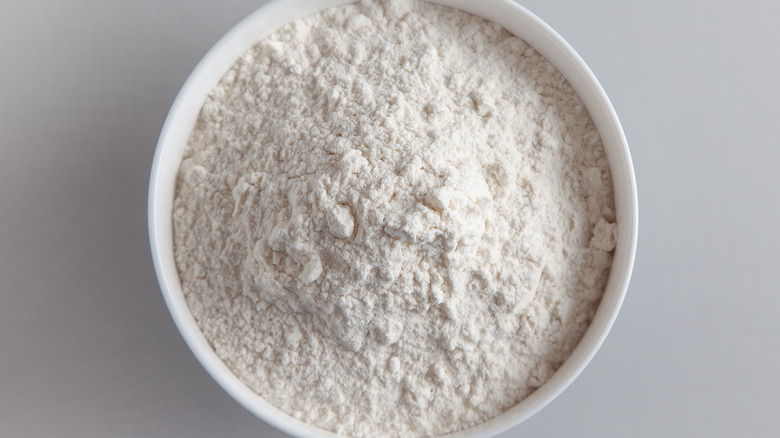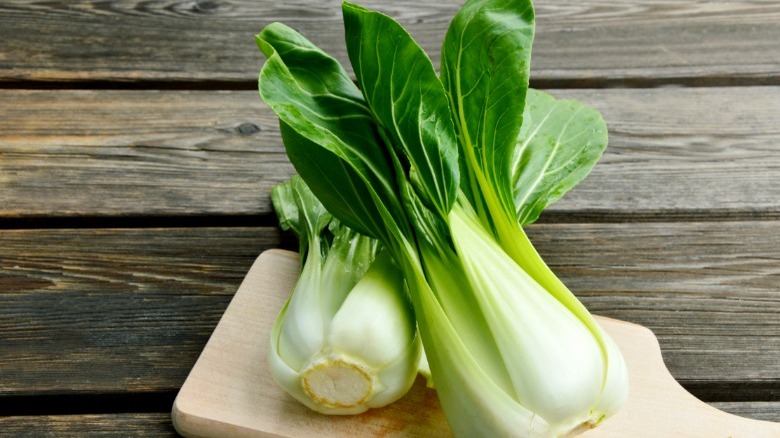13 Unique Ways To Use Sesame Seeds You May Not Have Thought Of
Sesame seeds have been consumed by humans for thousands and thousands of years. The Ancient Egyptians were one of the first populations to eat them, grinding the seeds into flour. People still do this today, but now the hulled seeds are used in everything from bagels to stir fries to halvah. There are so many reasons why it's a good idea to use sesame seeds. They have an earthy, nutty flavor and are incredibly versatile. They're good for you, too: Of the fats found in sesame seeds, 41% are polyunsaturated and 39% are monounsaturated. Unsaturated fats are considered healthy fats because eating more of them compared to saturated fats can reduce heart disease risk and lower cholesterol, according to Healthline.
White sesame seeds are the most common, but the black ones taste richer. Reddish ones have a strong smell, and brown sesame seeds are found in Indian cuisine. Unlike sunflower or pumpkin seeds, though, most people don't eat sesame seeds by the handful. Instead, they add them to recipes and sprinkle them on salad. Sesame seeds are tasty, nutritious, and affordable (about $10 for a whole pound), so it's worth getting a big jar or bag. As for what to do with then, it's time to veer off the beaten path — instead of using them in the expected ways, here are some unique ideas for inspiration.
1. Make sweet sesame seed candy
You might remember small, plastic-wrapped, square sesame seed candy from your grandmom's candy bowl. They're made with sesame seeds and sugar, with nothing more needed. You'll want to toast the sesame seeds first to bring out their flavor. To melt the sugar, cook it on low heat until it turns an amber color. Then, you can remove it from the heat and stir in the toasted seeds.
This stuff is incredibly sticky, so you'll need to sandwich it in between sheets of parchment paper on top of a baking sheet. Then, it can be flattened out with a rolling pin. Cut it into squares before it hardens, or you'll have to break it into pieces. This candy is sweet as can be and satisfyingly crunchy. To store it, wrap the hardened pieces in wax paper or plastic and keep them in a tightly sealed container.
2. Bake or fry sesame seed cookies
Here's another sweet treat that you'll want to stash in your office drawer or share with family and friends. Sesame seed cookies can be baked or fried and make wonderful snacks. They are made with dry ingredients like flour, sugar, and baking powder plus wet ingredients like butter, eggs, and vanilla. Toasted sesame seeds get folded in last, and the more, the better. You can also roll the cookies in a bowl of sesame seeds instead of adding the seeds to the batter, but why not do both? These cookies can be round or flattened; if you want to make them look more decorative, feel free to gently press almonds or other nuts into the tops.
Round sesame seed cookies can be fried in hot oil. These are called Chinese Laughing Balls, and we see why because these decadent delights make everyone smile — they're crispy on the outside and fluffy inside. Some versions are even made with a red bean paste filling ... like jelly-filled Munchkins but even tastier.
3. Go Japanese with miso eggplant
Circling back to the idea of healthy foods, miso eggplant can help you get in your five daily servings of fruits and vegetables. Eggplants are low in fat and good sources of essential amino acids, antioxidants, B vitamins, potassium, and Vitamin C. And guess what: Like tomatoes, they're classified as a fruit. The versatile purple varieties are thought to be slightly more nutritious and are just perfect for this recipe.
This vegetarian dish is called nasu dengaku and can be made in under half an hour. The eggplant gets sliced in half and browned in hot oil, and while that's cooking, a paste is made from sugar, miso, mirin, and sake. You can adjust the amounts according to your preference, but it shouldn't be too watery. The paste gets poured onto the eggplant halves, which head into the oven for a quick broil. The sesame seeds are the finishing touch once the eggplant miso is plated. Eggplant can be mushy, but the sautéing, broiling, and sesame seeds make it anything but.
4. Wake up your eggs
Bagels aren't the only breakfast food that gets a boost from sesame seeds. Eggs can be perked up with them too, and we're not talking about simply sprinkling the seeds on top. Adding eggs to your diet is a healthy idea because they're full of protein — two whole large ones contain about 13 grams of the stuff, as well as amino acids and iron. Two eggs also have 11 grams of fat, but it's mostly the good kind; roughly two thirds of it is unsaturated. One yolk has 200 milligrams of cholesterol, though, so if you need to be careful, Healthline advises that you check with your doctor about how much you can eat. Separating the eggs and only using one yolk or just the whites can help with this.
To make fried eggs with sesame seeds, heat a bit of butter or oil in a small pan and add the seeds. Crack an egg or two on top, and once the bottom is lightly browned, carefully flip it over, taking care not to break the yolk(s). Sprinkle on more seeds and slide it out when the bottom's cooked. Toasted sesame seeds also add taste and texture on top of poached eggs. To make sesame seed egg salad, smash hard-cooked eggs with a potato masher or fork and mix in mayo, salt, and the seeds.
5. Make sesame seed crackers
Seed crackers tend to be better for you than plain ones because they have more heart-healthy ingredients (via the American Heart Association). They may contain poppy, flax, sunflower, or pumpkin seeds. If you've never tried baking homemade crackers, they're an easy recipe that doesn't require much time or effort. We recommend using whole wheat flour and a mix of black and white sesame seeds for a richer, more satisfying taste and impressive appearance. There's no sugar used, and the fat content is minimal.
You don't need many ingredients for these crispy crackers. The dough is made with flour, sesame seeds, salt, and olive oil. The dough is more crumbly than bread dough and has to be rolled out and poked with holes before heading into the oven to be baked. These cook at a high temperature and brown in less than 10 minutes. They can be cut into squares, or you can use a round cookie cutter. Sesame seed crackers pair beautifully with dips and crudités.
6. Turn them into homemade tahini
Nothing compares to the taste of freshly made tahini, and there's no reason why you can't make it at home. Tahini isn't the same thing as hummus — that's made from cooked chickpeas, whereas tahini's made from sesame paste. This millennia-old food was first popularized in Middle Eastern cultures, and the best things about it are its smooth, silky texture and adaptability. Tahini is delicious enough when served plain, but you can add savory enhancements like chili powder and pesto or sweet flavors like cocoa and vanilla.
Homemade tahini can be prepared in a matter of minutes, and you don't have to measure out the ingredients. Puree toasted sesame seeds in a high-speed blender while adding a thin drizzle of sesame oil. Keep tasting it as you're going and feel free to experiment by adding different flavors. The final consistency should be slightly thinner than creamy peanut butter. You can slather this stuff on toast or use it as a dip. Add more oil or other liquid to thin it out when you want to use it as a sauce — it's dreamy on chicken, fish, and as a chocolate ice cream topping.
7. Puree sesame seeds for smoothies
Don't put that blender away just yet because sesame seeds are a natural addition to smoothie recipes. Health-food fans consider seeds to be superfoods and often blend them into these creamy, thick, and satisfying drinks. To add more nutrients, you can throw in some flax, hemp, and chia seeds, but we think sesame seeds add the best flavor.
To make a simple fruit-and-sesame-seed smoothie, you'll need to toast the sesame seeds first. Add some bananas, blueberries, or whatever fruit you desire, plus milk and any flavorings like cocoa powder, cinnamon, ginger, or vanilla. The ice gets added last, to make the smoothie nice and think. Sesame seeds also work well in savory smoothies that include things like cucumber, spinach, and kale. It's best to puree the seeds ahead of time because if you just sprinkle them in after blending the smoothie, they could get caught in your throat.
8. Liven up green beans
While canned green beans can only be livened up in green bean casseroles, we think that fresh ones can reach new heights when you add some crunch. A 100-gram serving of fresh, raw green beans has little fat or sugar, 7 grams of carbs, 1.8 grams of protein, 3.3 grams of sugar, and 2.7 grams of dietary fiber. It's also high in calcium and potassium. The nutritional value of frozen green beans is similar, but we're pushing you to use fresh ones because they taste soooo much better and have a crispier consistency when you stir-fry them and top them with sesame seeds.
To make a sesame seed and green bean stir-fry, use your fresh green beans within five days for the best flavor. Trim the beans and toast the sesame seeds beforehand. Add more flavor by sautéing the beans in sesame oil instead of vegetable oil, and incorporate fresh some sautéed garlic and soy sauce, as well. The key is to take the beans off the heat when they are tender-crisp instead of waiting until they're charred and soft. When that happens, you'll taste mostly soy sauce, and even the sesame seeds won't be able to save them.
9. Crunch up seafood dishes
You can sprinkle black and white sesame seeds on top of seafood, but making a thicker, satisfying crust with them takes things to a whole new level, especially with thick fish like salmon or tilapia. You'll want to pour white wine or rice wine vinegar on top for poaching purposes. Then, combine the seeds in a bowl with mayonnaise and breadcrumbs until it all turns into a workable paste to spread on top of the fish. The great thing about this mayonnaise-based paste is that you can play around with it. Try adding freshly grated parmesan, a touch of Dijon and horseradish, or finely chopped almonds.
What, you want salmon burgers or crab cakes instead? You can make a basic salmon burger with canned salmon, mayo, mustard, and breadcrumbs, and then mix in an egg white, seasonings, and toasted sesame seeds. The same process works with canned or fresh crabmeat. You can bake, sauté, fry, or grill these babies, and, of course, you'll want to serve them on sesame-seed buns.
10. Add them to pizza crusts
Who grabs a jar of sesame seeds to make homemade pizza? You should, because it'll send the pie in a completely different direction. To make your crust taste like a combination of traditional pizza and a sesame-seed bagel, add softened cream cheese to the mozzarella and spread it out over the pizza shell, with or without tomato sauce. The sesame seeds should be sprinkled on the edges after the pizza's cooked because high pizza-cooking temperatures can burn them.
After baking, while the pizza's still hot, sprinkle the seeds on top of the crust: If it's homemade, just press the seeds onto the edges. With a prepared crust like a Boboli, brush on melted butter, olive oil, or a nonstick spray first to help the seeds stick. As an alternative, omit all of the other toppings and brush the whole thing with olive oil when it comes out of the oven. Sprinkle the plain cooked pizza dough with black and white sesame seeds and cut it into narrow slices when it's cooled. We have an excellent dipping sauce idea: tahini.
11. Make sesame seed flour
Grocery stores contain many more varieties of flour nowadays instead of just bleached, unbleached, and cake flour. Now we have ones made from almonds, rye, whole wheat, and, yes, sesame seeds. The latter costs about $13 a pound, which is quite a bit more than plain flour. So if you have extra seeds and want to try this at home, it's not that complicated. And like coconut and almond flour, this stuff can be used in keto baking.
It's best to use defatted sesame seeds to make this flour because the seeds' oils can make the flour go bad sooner. You can grind them into a powder with a food processor, coffee grinder, or spice grinder. Do a little bit at a time to get started, and once you see how much flour's produced from a certain amount of seeds, you'll be more comfortable. Use this to make delicious pancakes, zucchini bread, and other baked goods.
12. Milk them for all they're worth
There are plenty of plant-based milk products out there — you've seen coconut and almond milk in the stores but probably not sesame milk. That could be changing soon, with newer brands like Hope and Sesame that make their own versions. Sesame seed milk doesn't require a lot of water for production when compared to oat, almond, and cow's milk. Some store-bought versions contain oil, but all are non-dairy. This kind of milk has a different taste that you will notice on the first sip. You might enjoy drinking it straight, over cereal, or in your coffee. It's best to make just a small portion at first in case your taste buds don't agree with it. The flavor isn't that sweet, so it can also pair well with savory food.
To make homemade sesame milk, the seeds must be in lightly salted water for eight hours or overnight. Then, they're added to blender for pureeing. At this point, feel free to add a few softened, pitted dates or raisins and flavorings like vanilla and cinnamon. Once the mixture is liquified, it has to be squeezed and strained out through a cheesecloth into a container. This will last up to three days, covered tightly in the fridge.
13. Do a bok choy salad
If a head of Romaine lettuce and a bunch of celery had a baby, it might look something like bok choy. This leafy green vegetable is often sautéed and used in Asian dishes but also makes for an interesting, multi-textured salad. A 1-cup serving of healthy bok choy has impressive amounts of calcium, potassium, and vitamins A, C, and K. It's also low in fat and has 1.1 grams of protein. Large bok choy is not as sweet as baby bok choy and has bigger, tougher leaves. So if you want a heartier salad, use the larger kind. Just be sure to wash the bok choy under the faucet because it tends to harbor hidden dirt on the bottoms of the stems.
A good bok choy salad combines different textures, but if you're making it ahead of time, don't combine the ingredients or add the dressing until right before serving. Otherwise, the crunchier parts will get soft. While the bok choy's drying, an easy dressing can be made from pureed sesame seeds, soy sauce, olive oil, sugar, and vinegar. If you don't want to take out the blender, whisk together the liquid ingredients and sprinkle on the seeds at the end. This salad gets even more crunch from uncooked ramen noodles, or sliced almonds — these can be used as is or sautéed. To assemble the salad, put the bok choy into a large bowl and add sliced scallions or diced onions. Pour the crunchy mixture on the greens, add the pureed dressing, mix well, and sprinkle with ... well, you know.
